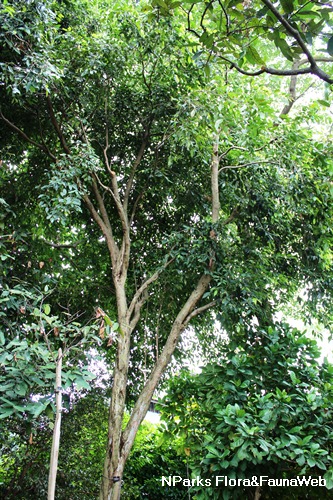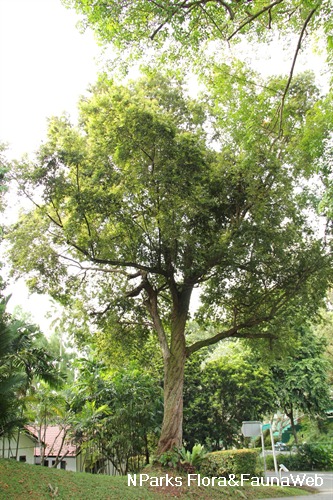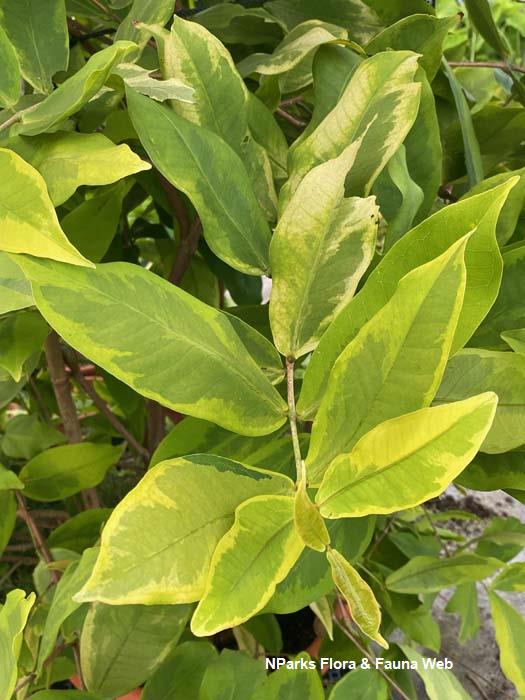
Back
Syzygium attenuatum (Miq.) Merr. & L.M.Perry
| Family Name: | Myrtaceae |
Syzygium attenuatum is a tree that can grow up to 15 m tall and is found in rainforests and montane forests. Its leaves often bear a long, tapering tip and show considerable variation in size and venation. The tree produces fleshy, berry-like fruits that may be white, cream, or red in colour.
Name
Classifications and Characteristics
| Plant Division | Angiosperms (Flowering Seed Plants) |
|---|---|
| Plant Growth Form | Tree |
| Lifespan (in Singapore) | Perennial |
| Mode of Nutrition | Autotrophic |
| Maximum Height | 15 m |
Biogeography
| Native Distribution | Southeast Asia to New Guinea |
|---|---|
| Native Habitat | Terrestrial |
| Preferred Climate Zone | Tropical |
| Local Conservation Status | Non-native |
Description and Ethnobotany
| Growth Form | It is a tree, up to 15 m tall, with reddish brown or grey bark. |
|---|---|
| Foliage | The leaves are leathery and in opposite arrangement. They are elliptic or oblong (5 – 12 cm long and 2.6 – 5.4 cm wide). The leaf tip is long and tapering (acuminate), with a distinct acumen while the leaf base is narrow (cuneate). Each leaf has 14 – 34 pairs of lateral veins. The intramarginal veins lie close to margin (about 0.5 mm away) and are hardly looped. The petiole is short, about 0.4 - 1 cm long. It is highly variable in its leaf size and venation. |
| Flowers | The flowers occur in a branched cluster (panicle) at the terminal ends, reaching up to 4.2 – 7.5 cm long. They are small and sessile, with 4 sepals, 4 petals, many stamens and a short style (1 – 1.5 mm long). |
| Fruit | The fruit is ellipsoid, about 1 cm long and 0.5 cm wide, with a smooth surface. It is berry-like, fleshy, and can be white, cream, red colour. The calyx ring is present and shallow. The seed has not been observed. |
| Habitat | It is found in rainforests and montane forests, up to 1100 - 1300 m altitude. |
| Associated Fauna | Flowers are pollinated by insects. |
| Etymology | The genus epithet syzygos, in Greek, means partner or joined, referring to the paired leaves of this species. Specific epithet attenuatum, in Latin, means slender, referring to the plant’s leaf tip. |
Plant Care and Propagation
| Light Preference | Full Sun |
|---|---|
| Water Preference | Moderate Water |
| Plant Growth Rate | Moderate |
Foliar
| Mature Foliage Colour(s) | Green |
|---|---|
| Mature Foliage Texture(s) | Leathery |
| Foliar Type | Simple / Unifoliate |
| Foliar Arrangement Along Stem | Opposite |
| Foliar Attachment to Stem | Petiolate |
| Foliar Apex - Tip | Acuminate |
| Foliar Base | Cuneate |
Non - Foliar and Storage
| Trunk Type (Non Palm) | Woody |
|---|---|
| Root Type | Underground |
Floral (Angiosperm)
| Flower & Plant Sexuality | Bisexual Flowers |
| Flower Grouping | Cluster / Inflorescence |
|---|---|
| Flower Location | Terminal |
| Inflorescence Type | Panicle |
Fruit, Seed and Spore
| Mature Fruit Colour(s) | White, Cream / Off-White, Red |
|---|---|
| Mature Fruit Texture(s) | Smooth |
| Fruit Classification | Simple Fruit |
| Fruit Type |
References
| References | <1> Ashton, P.S. (2011). Myrtaceae s.l. In: Soepadmo, E., Saw, L.G., Chung, R.C.K. & Kiew, R. (eds) Tree Flora of Sabah and Sarawak 7: 87–330. Malaysia: Sabah Forestry Department, Forest Research Institute Malaysia (FRIM), Sarawak Forestry Department. <2> Craven, L.A. (2019). Studies in Papuasian Syzygium (Myrtaceae): 1. Subgenus Perikion revised. Blumea 64: 115 – 122 <3> Parnell, J.A.N., & Chantaranothai, P. (2002). Myrtaceae. In: Larsen, K. & Santisuk, T. (eds.) Flora of Thailand, vol. 7 (4), pp. 778–914. Bangkok: Prachachon Co. Ltd. <4> Soh, W.K., & Parnell, J. (2015). A revision of Syzygium Gaertn. (Myrtaceae) in Indochina (Cambodia, Laos and Vietnam). Adansonia sér. 3, 37 (2): 179 – 275
|
|---|
Image Repository
Others
| Master ID | 33296 |
|---|---|
| Species ID | 7710 |
| Flora Disclaimer | The information in this website has been compiled from reliable sources, such as reference works on medicinal plants. It is not a substitute for medical advice or treatment and NParks does not purport to provide any medical advice. Readers should always consult his/her physician before using or consuming a plant for medicinal purposes. |



